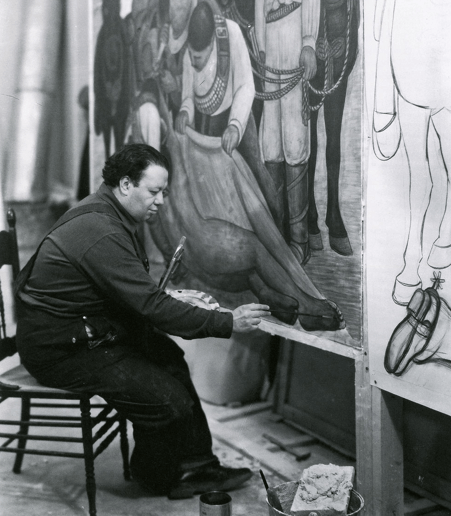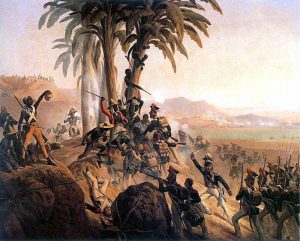Winner of the Spring 2017 StMU History Media Awards for
Best Article in the Category of “Culture”
When entering a Mexican restaurant today, one takes notice of the different aromas, both sweet and savory; one notices the patrons often speaking their language of Spanish; one hears the vibrant tunes of a jukebox; however, one might ask whether the art hanging on the walls of the restaurant isn’t also worthy of the patrons’ attention? One may have seen the famous work of art depicting a woman of colored skin, brown as sugar, contrasting with the white of beautiful calla lilies; or, if not, one might at least be familiar with another work by that same painter.1 The name of this artist, who is known far beyond the Mexican restaurants that hang his famous paintings and murals, is Diego Rivera.

Born in Guanajuato, Mexico, on December 8, 1886, Rivera grew up always seeming to have a hand for creating art. As a child, he had his own studio to work in and later he was granted a scholarship that allowed him to take his talent to Europe, especially to France, where he spent ten years expanding and perfecting his techniques. He is best known for his many influential murals and paintings that illustrate the struggles and lifestyles of the Mexican working class. Among his most famous murals is The History of Mexico from the Conquest to 1930, housed in the National Palace in Mexico City; The Making of a Fresco in San Francisco; and Detroit Industry, located in the city that was home to the American industrial worker in the early twentieth century.2

In the autumn of 1922, Rivera joined the Mexican Communist Party. This organization positively impacted the Mexican community through supporting miners’, factory workers’, and farmers’ rights. With the support of those miners, factory workers, and farmers, Rivera formed the Union of Technical Workers, Painters, and Sculptors. Through the Union, Rivera opened free art schools all over Mexico, through which he was able to spark the Mexican mural movement, enabling his protégés to showcase their art, inspired by Rivera’s own murals. Rivera became well-known in Mexico, and even people from different countries came to his Union to participate.3

In 1929, Rivera began working on a series of frescoes titled History of Mexico from the Conquest to 1930. The art piece took twenty years to complete because of minor adjustments and additions, and he also worked on other pieces in the interim. However, during this time of his busiest artistic activity, he was expelled from the Mexican Communist Party for being “too busy” painting. Despite his expulsion, he continued to favor the working class and always believed he was one of them.4 On February 9, 1934, Nelson Rockefeller was said to have sent workers to destroy a mural located in the Rockefeller Center in New York City, a mural Rivera had spent many weeks painting with smooth precision. The painting was destroyed because of a portrait of Vladimir Lenin painted in the mural, which was not originally in the sketch sent for Rockefeller’s approval. This left Rivera in a state of depression and exhaustion after realizing his hard work was put to waste, without even being given a chance to be named.

Despite the controversies Rivera encountered throughout his career he was still a magnificent painter and influenced much of Mexico’s national art.5 In 1947, another one of Rivera’s murals heated his audience, Dream of a Sunday Afternoon in the Alameda. It was located in the Hotel del Prado across the street from Alameda and the painting covered the history of the park and its peoples (from Rivera’s perspective) all the way from the years of the Spanish Inquisition to the Mexican Revolution. The reason it sparked criticism and caused demonstrators to slash the fresco was because the words “God does not exist” were written in the mural. Rivera, of course, repaired the damages made. In 1956, a year before his death, he announced “I am a Catholic,” and changed the wording on the fresco.6 It was among one of the last great murals he painted. But despite the controversies that Rivera encountered throughout his career, he was still a magnificent painter and influenced much of Mexico’s national art.7

In addition to being a hard worker and a talented painter, Rivera was also great with the ladies. While in Paris he first became engaged to a Russian artist named Angelina Beloff, with whom he had a son, Diego Jr., who unfortunately died at fourteen months from the influenza epidemic of 1919-1920.8 In 1921, he returned to Mexico, where he met a fine beauty from Guadalajara named Lupe Marin. Just a short year later they were married, leaving Angelina in Paris still believing that they were engaged. In the years that followed, Marin bore Diego two daughters, Guadalupe and Ruth.9 However, his infidelity caused their marriage to fall apart, with Marin left raising their daughters on her own. By 1929, Rivera had already remarried, but this time to the famous Frida Kahlo.10

Rivera was working on a painting in the National Palace in Mexico City when Frida approached him; she requested that he get down from the scaffold and give his honest opinion on her own work. After looking at her work, he called it “an unusual energy of expression,” calling her an authentic artist. She invited him to see more of her work at her home in Coyoacán. From there, a friendship blossomed, and soon they fell in love.11 Their marriage was not like any ordinary marriage; it was an emotional roller coaster of a relationship that was well depicted in both of their works, especially in Kahlo’s. She accompanied him everywhere: San Francisco, New York, Detroit, and many other places. They managed for many years, up until Rivera became involved with Frida’s younger sister. They then divorced in 1940.

During this time, Leon Trotsky (Soviet politician) was a target for many agents of Joseph Stalin and was found in his home with a pickaxe jabbed in his head.12 Previously, Rivera and Frida’s home in Coyoacán served as an asylum for Trotsky and his wife as a refuge from these assassins of Stalin’s. While in their home Casa Azul, Kahlo and Trotsky had an amorous affair, and a subsequent quarrel between him and Rivera.13 Rivera cut off any interaction with Trotsky and fled to San Francisco, where he started working on a mural. The police questioned Kahlo about Trotsky’s death, and she later followed Rivera to San Francisco. They remarried that same year, and despite his infidelities, they continued to be passionately in love. However, in 1954, after fourteen more mercurial years of marriage, Kahlo died, and Rivera mourned her death for a year before marrying his third wife, Emma Hurtado. Diego Rivera had a way with women, and his big belly and smelly self did not get in the way of his passion for both art and women.

Rivera was heavily involved in politics at an early stage of his life and continued to be up until his death. In 1955, he was diagnosed with cancer and traveled all the way from Mexico to Moscow to get treatment. Two years later, on November 24th, he passed away in his home in San Angel, Mexico City, Mexico. He wanted his ashes to be spread alongside those of Frida Kahlo in a templo he built; instead, he was buried. Rivera was head of the Anti-Imperialist League and held memberships in the National Peasant League and the Workers’ and Peasants’ Bloc. Also, he rededicated himself to the Mexican Communist Party in 1926 and was a delegate to the Moscow Peasant Congress in 1936.14 Rivera in many ways resembled the indigenous people of the working class illustrated in his works of art. Not only did they share the same native country, but they too were concerned for the political movement and the aftermath of the Mexican Revolution, and they too had the passion and drive to continue working hard, in both sickness and in health.
- Diego Rivera, “Desnudo con Alcatraces,” painting in oil, 1944, original in Private Collection. ↵
- Susan Goldman Rubin, Diego Rivera: An Artist for the People (New York: Abrams Books for Young Readers, 2013), 6. ↵
- Susan Goldman Rubin, Diego Rivera: An Artist for the People (New York: Abrams Books for Young Readers, 2013), 16. ↵
- Susan Goldman Rubin, Diego Rivera: An Artist for the People (New York: Abrams Books for Young Readers, 2013), 22. ↵
- Susan Goldman Rubin, Diego Rivera: An Artist for the People (New York: Abrams Books for Young Readers, 2013), 26. ↵
- William Stockton, “Rivera Mural in Mexico Awaits it New Shelter,” New York Times, January 4, 1987. Accessed April 17, 2017. http://www.nytimes.com/1987/01/04/arts/rivera-mural-in-mexico-awaits-its-new-shelter.html. ↵
- Susan Goldman Rubin, Diego Rivera: An Artist for the People (New York: Abrams Books for Young Readers, 2013), 26. ↵
- Susan Goldman Rubin, Diego Rivera: An Artist for the People (New York: Abrams Books for Young Readers, 2013), 12-13. ↵
- Susan Goldman Rubin, Diego Rivera: An Artist for the People (New York: Abrams Books for Young Readers, 2013), 16-18. ↵
- Frida Kahlo was an iconic revolutionary Mexican artist widely recognized for her disturbing personal self-portraits of the female body and known for her Tehuana style. See Encyclopedia of Activism and Social Justice, 2007, s.v. “Kahlo, Frida (1907–1954),” by Gary L. Anderson and Kathryn G. Herr. ↵
- Susan Goldman Rubin, Diego Rivera: An Artist for the People (New York: Abrams Books for Young Readers, 2013), 18-21. ↵
- Encyclopedia of Activism and Social Justice, 2007, s.v. “Trotsky, Leon (1879–1940),” by Gary L. Anderson and Kathryn G. Herr. ↵
- Encyclopedia of Sex and Gender, 2007, s.v. “Kahlo, Frida (1907–1954),” by Fedwa Malti-Douglas. ↵
- Encyclopedia of Activism and Social Justice, 2007, s.v. “Rivera, Diego (1886–1957),” by Gary L. Anderson and Kathryn G. Herr. ↵



127 comments
Peter Alva
I only knew of him being an artist but I never really understood what his paintings meant after reading this article. I did not think of him to be that kind of artist but to the people of Mexico, his Murals do mean a lot. As someone who lives on a side of town that has a lot of them, I can say that they do help the public see themselves through art and just the art of Murals for the public truly help them understand who they are to the area.
Barbara Ortiz
Congratulations on your award. I really enjoyed reading your article about Diego Rivera. What a talented painter he was and that “Desnudo Con Alcatraces” is definitely an iconic piece of his. I also always found it interesting after seeing pictures of him, that he was such a “ladies man.” The other part of your article that I was not aware of until very recently was the fact that Trotsky was found killed in their home, or that Frida and Trotsky were also romantically involved.
Jared Sherer
I enjoyed reading about Diego Rivera and about his moving artwork. The author did a good job explaining his love for art and his participation in politics. I have never heard about this man but I thought the descriptive article and images helped me learn a lot about this man and his views on the world. I learned that Diego built art schools all around Mexico which I thought was cool. The article explains his life and how he overcame his hardships and stuck to his own in what he believed in. The murals I believe are a way for him to express himself and how he views everything around him. I enjoyed the article and I think it was very well written by the author. The pictures used in the article were very well chosen, very colorful, and helped with my understanding of the text and message of the article.
Noelia Torres Guillen
I’ve learned a lot from this article. To be honest I never really thought about Diego Rivera and who he was besides being married to Frida Kahlo. I knew he was an artist but not to the extent of him making murals and paintings that reflected the working class in Mexico. I guess when I think of communism my mind doesn’t automatically go to Mexico. But it’s an important part of history that a lot more people should learn about.
Adelina Wueste
This article was great! I really enjoyed how you included so many images of Diego Rivera’s artwork. Through the images I was able to see what you were describing in your article, and I was able to understand different ideas that Rivera portrayed through his art. I found interesting that Rockefeller destroyed one of Rivera’s paintings because Vladimir Lenin was included. I think this article did a great job of describing both Rivera’s life and the way that he and his art tied into and effected politics.
Azeneth Lozano
First of all, congratulations all your well-deserved award! This was a wonderful article, and I loved your opening paragraph. It was interesting to learn about the passion Diego Rivera had for not only art, but for politics and women as well. It was a complete surprise to me to learn that he had joined the Mexican Communist Party but was later “expelled” for being “too busy painting.” Overall, interesting story about Frida Kahlo’s husband and his life.
Anayetzin Chavez Ochoa
I have done a fair share of research for school revolving around Frida Khalo, so my knowledge of Diego Rivera is mostly from her perspective and her love/hate push-and-pull narrative. I didn’t know he built art schools all over Mexico, how cool! Thank you for writing this.
Melyna Martinez
The impact of Diego Rivera’s work is not only something that impacts Mexico’s culture but it impacted political issues. The work Rivera did was not only beautiful but had a meaning that needed to be seen. Diego Rivera’s art alongside Frida Kahlo’s work showed Mexico through the art but they also fought for the community and the need for political change at the time.
Alexandra Camarena
This article was great! I loved the way the author set up the format! This is because it really highlighted his artwork but also his journey to getting to where he is now. While I had always heard of him and how he was married to Frida Khalo, I never actually knew anything about how he got into being an artist. So to learnt that he went to a art school in France was very shocking.
Vianne Beltran
Hi Gabriela,
I think your article does an excellent job of explaining the importance of Diego Rivera for Mexican culture. Your article also highlights how impactful art and the action of creating it can be. I think it’s interesting he was expelled from the Mexican Communism Party for being too “busy.” I imagine he was probably the one in the party doing the most for his community with his free art schools.